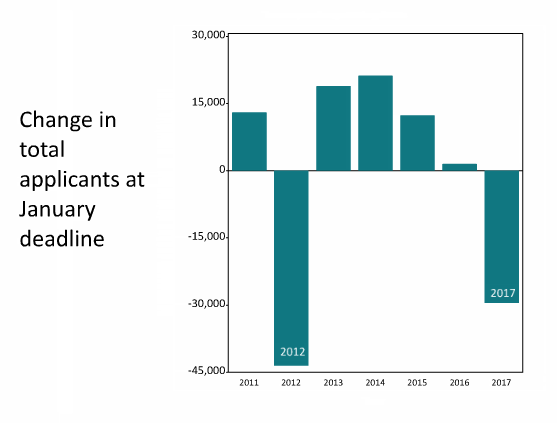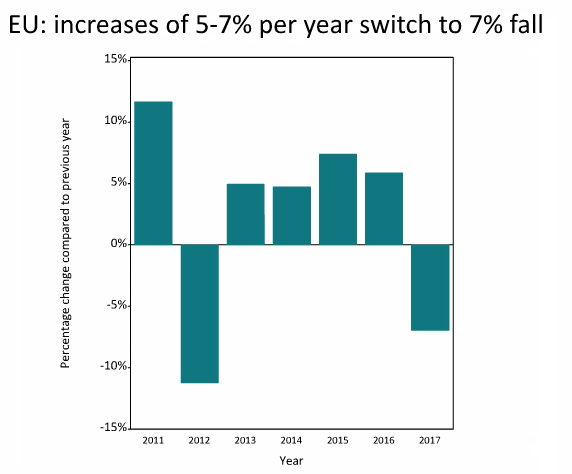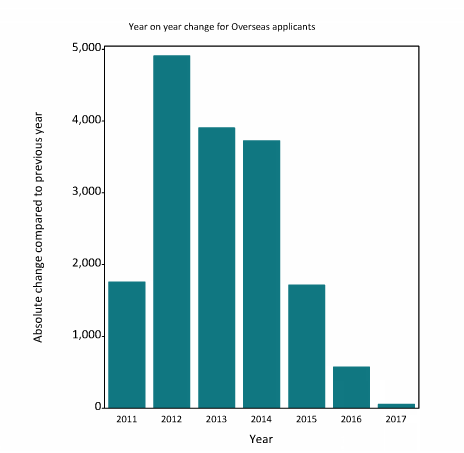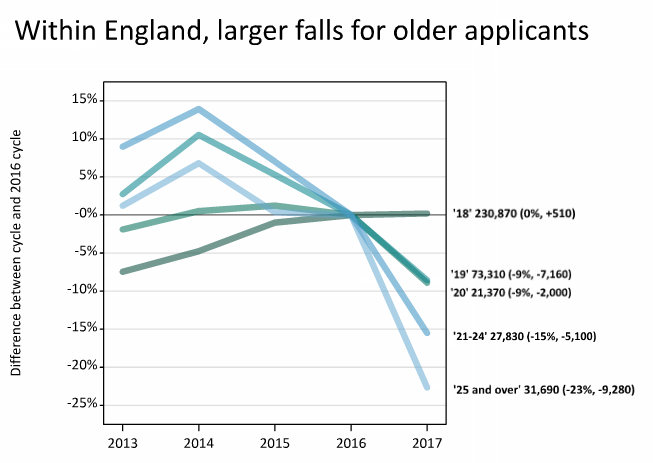Applications from European Union students to study at UK universities have fallen by 7 per cent following the nation’s Brexit vote, part of an overall 5 per cent decline in applications from all students.
Ucas figures published on 2 February show that to date a total of 564,190 people have applied for full-time undergraduate study at UK higher education institutions for 2017, a decrease of 5 per cent compared with the same point last year.
Ucas analysis of applications made by the 15 January deadline, the first reliable indicator of demand for 2017 entry, suggests four factors behind the overall decline: falling demand from EU students, for nursing courses following the abolition of bursaries in England, from students in older age groups, and a slowdown in growth in applications from 18-year-olds.
Applicants from England making at least one course choice to nursing fell by 23 per cent to 33,810.
Each UK nation saw falls in applications: England (6 per cent), Northern Ireland (5 per cent), Scotland (2 per cent) and Wales (7 per cent).
In England, the proportion of 18-year-olds in the population who apply to university has risen to a record high of 37 per cent, but the increase is smaller than in recent years.
The application rate for young people living in areas least represented in higher education increased to 22.5 per cent in England, the highest level recorded.
Mark Corver, Ucas director of analysis and research, said that falls in application numbers were “historically quite unusual”, with this being the second largest of only three declines at UK level since the current applications system began in 2002.
The previous years to see falls in applications were 2006 (when tuition fees of £3,000 were introduced) and 2012 (when fees were trebled to £9,000).

This year’s decline “unwinds” growth in recent years and takes application numbers back to 2013 levels, Dr Corver told journalists at a briefing in London.
EU student applications dropped by 7 per cent to 42,070, a fall that follows the UK’s vote to leave the EU in June 2016. The number of EU applications had previously been increasing by between 5 and 7 per cent each year, leaving this year’s figures 6,000 below what would be expected on past trends, Dr Corver said.

EU students currently have access to the UK’s public-backed fee loans system and are subject to the same tuition fee cap as home students. The government announced in October that EU students applying for 2017 entry will remain subject to this regime for the duration of their courses.
Non-EU student applications have stagnated, showing little change from the previous year at 52,630 (although many overseas students do not use the Ucas route, the trend may alarm universities).

The bulk of the overall decline came from applications from UK-domiciled students, which decreased by 5 per cent to 469,490.
One of the factors here was the decline in applications to nursing, where students tend to be older. Dr Corver said that the decline in applications from older students was “key” in understanding a number of trends.

Similarly, applications from black students – who also tend to be older – showed a 10 per cent decline, the biggest for any ethnic group. Yet applications from black 18-year-olds were up 1 per cent.
Dr Corver said that the sharpening of the trend for falls in applications from older students this year could be down to a number of factors: increases in applications from 18-year-olds over a number of years meaning that there is less demand from older age groups, and the job market becoming more attractive than studying.
“Slower-than-trend” growth in 18-year-old applications meant that application numbers from that group were 7,000 below the level that could have been expected if growth had continued on the trajectory of recent years, said Dr Corver.
He also pointed out that universities may be able to avoid a fall in student numbers arriving at institutions this autumn, despite the fall in applications, if they adjust their offer rates.
The decline in applications has had the deepest impact at lower-tariff institutions, Ucas analysis suggests.

Register to continue
Why register?
- Registration is free and only takes a moment
- Once registered, you can read 3 articles a month
- Sign up for our newsletter
Subscribe
Or subscribe for unlimited access to:
- Unlimited access to news, views, insights & reviews
- Digital editions
- Digital access to THE’s university and college rankings analysis
Already registered or a current subscriber?







